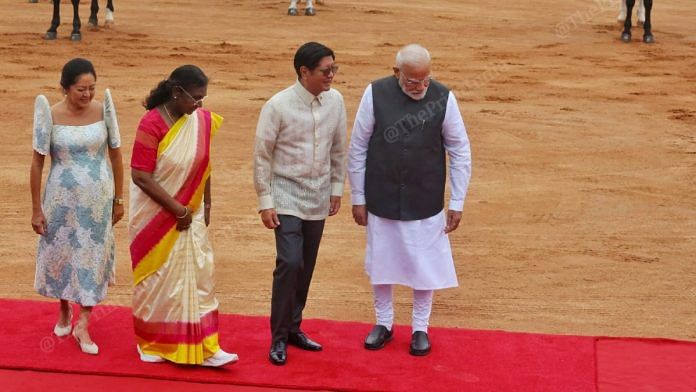New Delhi: Prime Minister Narendra Modi pushed for the completion of the review of the ASEAN free trade agreement Tuesday, as India elevated its ties with the Philippines to a “Strategic Partnership” with a focus on deepening the defence partnership with the South East Asian nation.
“Today, the President (of the Philippines) and I discussed bilateral cooperation, regional issues and the international situation. It is a matter of happiness that today we have decided to give our relations the status of Strategic Partnership. A comprehensive Action Plan has also been prepared to convert the potential of this partnership into results,” Modi said during a joint press statement with the President of the Philippines Ferdinand R. Marcos Jr.
The Indian Prime Minister added: “Our bilateral trade is constantly growing and has crossed the figure of $3 billion. To strengthen it further, it is our priority to complete the review of India-ASEAN Free Trade Agreement as soon as possible. Along with this, we have also decided to work towards a bilateral Preferential Trade Agreement.”
India and ASEAN (Association of Southeast Asian Nations, a 10-member regional organisation) have been reviewing the free trade agreement since 2023. The FTA came into force in 2010. However, the trade agreement saw India’s deficits with ASEAN balloon to over $40 billion in 2022-2023, which led to fears of China dumping its products in the Indian market through the 10-member bloc, according to reports.
Nine rounds of negotiations have since been held. However, the progress has frustrated India, with Minister of Commerce and Industry Piyush Goyal going so far as to label ASEAN as “China’s B-Team” in public comments last month. The comments caused a flurry among ASEAN leaders, especially given the focus Modi has placed on India’s ‘Act-East Policy’.
The Modi-Marcos Jr. meeting witnessed both countries agreeing to terms of reference for the negotiations of a preferential trade agreement between New Delhi and Manila. The President of the Philippines is in India for a five-day visit from 4 August to 8 August. Marcos Jr. is set to travel to Bengaluru as well after completion of his official visit to New Delhi.
Also read: As China’s two-ocean push looms large, India and the Philippines are closing ranks
Strategic convergence between New Delhi & Manila
Manila has increasingly become an important partner for India in South East Asia, given its own security challenges vis-a-vis China in the South China Sea. The Philippines procured the BrahMos supersonic cruise missile platform from India three years ago for $374 million. It was the first such export of the missile system.
Modi and Marcos Jr witnessed the exchange of nine agreements, including the terms of reference for staff-level talks between the tri-services of India and the Philippines. On Sunday, the day before Marcos’ travel to New Delhi, the navies of the two countries staged its first joint naval drill in the South China Sea—a move that is bound to irritate China.
Both countries have long-running border disputes with China. For India, ties with Beijing have seen a small thaw at the political level in recent months after ties had cratered between New Delhi and Beijing after the military clashes in Galwan during the summer of 2020.
However, following disengagement at the friction points across the Line of Actual Control (LAC) last October, both India and China have engaged in certain confidence-building measures, including the resumption of the Kailash Mansarovar Yatra by Beijing and the issuance of tourist visas to Chinese nationals by New Delhi.
Manila has been facing an increasingly dominant China in the South China Sea. Over the past couple of years, its forces have been involved in aggressive incidents conducted by China’s forces in the South China Sea. Both countries have a territorial dispute over the Scarborough Shoal and the Spratly Islands in the South China Sea.
An arbitral tribunal at the Permanent Court of Arbitration in The Hague in 2016 announced that China’s territorial claim based on the “nine-dash line”—a set of line segments drawn by Beijing to lay claim to parts of the South China Sea—had no legal basis under the United Nations Convention on the Law of the Sea (UNCLOS).
The Philippines’ forces have seen their ships rammed by the Chinese coast guard, and in some cases Beijing’s forces have even used water cannons in an attempt to prevent the movement of Manila’s forces in the South China Sea.
Without making a reference to China, Modi indicated India’s support for “peace, security, prosperity and rules-based order in the Indo-Pacific region”. The Indian Prime Minister further added that New Delhi backs the “freedom of navigation in accordance with international laws”.
(Edited by Viny Mishra)






